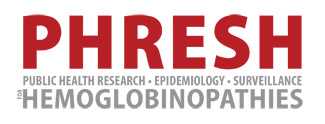Public Health Research, Epidemiology, and Surveillance for Hemoglobinopathies (PHRESH)

To expand and learn more about the information collected during the RuSH project, the CDC started a new hemoglobinopathies project. This project, Public Health Research and Surveillance for Hemoglobinopathies (PHRESH), focused on two areas: surveillance (monitoring) and health promotion and prevention of health complications. The project was a collaborative effort with California, Mississippi, and Georgia from 2012-2014.
The primary goals and objectives of PHRESH were:
- To develop a monitoring program within a defined geographic area that provides accurate information on the burden of disease (how the disease impacts individuals and communities)
- To carry out activities that promote health and prevent health complications by improving the quality of care for people with hemoglobinopathies (particularly focusing on vaccines/shots), early and continuous screening (especially transcranial Doppler screening), and the use of appropriate treatments

The information gained from PHRESH serves as a model for national and international agencies to address the developing needs of people living with hemoglobinopathies.
As a result of RuSH and PHRESH, we have:
- Learned roughly the number of people living with hemoglobinopathies in the 8 participating states and better understand their use of health services;
- Increased access to health education materials for people living with hemoglobinopathies, their families, and health care providers;
- Increased awareness about ways to reduce health problems due to hemoglobinopathies;
- Developed hemoglobinopathy monitoring processes including the methods for collecting information which will make it easier to conduct this project on a larger scale in the future.
- Page last reviewed: August 9, 2017
- Page last updated: August 10, 2016
- Content source:



 ShareCompartir
ShareCompartir